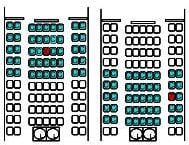At a glance
What if a passenger was sick on your flight? What if that person was later diagnosed with a serious infectious disease and was contagious during your flight? Are you at risk? If you were exposed, how do you protect yourself?

Answering the call
A contact investigation often starts with a phone call to a CDC Port Health Station located at a U.S. international airport. The caller is a public health official who informs CDC about a recent air traveler diagnosed with a specific contagious disease. Sometimes CDC is notified about a sick traveler while the plane is still in the air or shortly after the plane has landed. However, in most cases CDC is notified when a sick traveler seeks treatment at a medical facility. These notifications can be made days, weeks, or even months after the travel. This sick traveler is now referred to as the "index patient."
The caller notifies CDC because other passengers on the arriving international flight or connecting domestic flights may have been exposed and need to be notified. Or an international partner calls CDC about exposed U.S. passengers on overseas flights. The passengers exposed to the index patient are called "contacts."
CDC is responsible for coordinating contact investigations of illness exposures on arriving international flights or flights between states. A single infected traveler can trigger more than one contact investigation if the traveler takes connecting flights to reach a U.S. destination.
A person can be contagious without showing any symptoms while the disease is developing (incubating) in the body. Port health protection officers must determine whether the index patient was contagious during a flight. Their decision is based on the disease, history of symptoms, and date of the flight.
Starting the contact investigation
If the index patient was contagious during the flight, passengers seated nearby may have been exposed to the disease. CDC will start a contact investigation to find these passengers.
CDC requests the flight manifest data for passengers seated near the index patient. The flight manifest is a document that contains passengers' names, seat numbers, and contact information. CDC guards the privacy of passengers by keeping this information secure.
This is a good reminder to make sure you give the correct contact information to the airlines when you book your flight! Also, remember to update your frequent flyer program contact information.
Diseases of concern during air travel
Most flight contact investigations are performed for infectious tuberculosis (TB), measles, rubella (German measles), pertussis (whooping cough), and meningococcal disease (meningitis).

CDC has developed instructions (protocols) for investigating contagious diseases on airplanes. CDC uses these protocols to identify passengers who may have been exposed during a flight. Identifying contacts is based on the disease, how it spreads, and where a passenger was seated in relation to the index patient.
Two examples are shown above of the seating chart used for TB, measles, and rubella contact investigations. Shown in blue-green are the seats of the exposed passengers who will be notified. They sat in the same row, two rows in front of, and two rows behind the index patient (shown in red). Only passengers seated in the contact zone are considered at risk. The contact zone will differ based on the disease and transmission method.
There are two exceptions to the seating chart shown. Two types of passengers will be considered contacts regardless of where they sat:
- All traveling companions of the index patient who were on the same flight
- For measles and rubella, all children younger than 2 years seated on adult passengers' laps. These children may be too young to have been vaccinated and would be at high risk for getting the disease.
Did you provide accurate information?
Contact information from the flight manifest is often incomplete.
For domestic flights, providing a current telephone number and email address to the airline when making your flight reservations helps ensure CDC has accurate contact information for you in the event of an exposure.
CDC relies on U.S. Customs and Border Protection (CBP) for help with contact investigations involving international flights. CBP can often provide more information that fills in the gaps.
CDC staff combine the information from CBP and the airline's flight manifest for locating exposed passengers (contacts). At every step, CDC protects the privacy of this information.
Protecting the health of passengers
CDC provides the exposed passengers' contact information to state and local health departments or ministries of health in the countries where the passengers live. These agencies then try to locate these passengers and inform them about their exposure and what to do.
Exposed passengers (contacts) may be asked whether they are protected against (immune to) the specific disease. They can be immune if they had the disease in the past or have received a vaccine.
Public health officers will educate contacts about how to watch for and report symptoms of the illness being investigated. Contacts who aren't immune (for example, because they haven't been vaccinated for the disease) may be offered preventive drugs or a vaccine to protect them from the disease. Any recommendations will be based on the disease, availability of preventive drugs or vaccines, and amount of time passed since exposure.
The contact investigation process is how federal agencies and airlines work together to help state and local health departments find and notify exposed passengers. If you are considered a contact of an index patient on an airplane, your health department will call you.
